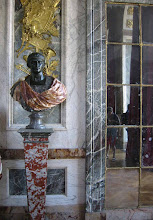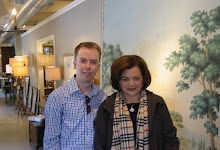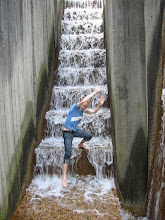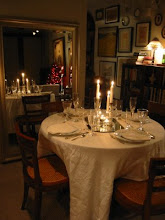Richmond is full of historic house museums as you've seen in my previous posts. One last museum I'll share with you is Maymont.
Built in Romanesque style by architect Edgerton Stewart Rogers in 1893 high above the banks of the James River, the mansion and 100 acre estate was home to James and Sallie Dooley.
The house and grounds have been a public museum and park since 1925 when Mrs. Dooley passed away.
The imposing stone facade hides a rather giddy and over the top Victorian interior.
The grounds are beautiful with stunning views down to the river.
The original outbuildings of the estate survive and are used to this day in the maintenance of the house and park.
I especially loved this carriage barn with service court. Wouldn't this make a charming house?
The water tower is located right behind the carriage house.
The Dooleys are buried together on the estate on a bluff overlooking the James river in a beautiful mausoleum designed by William Churchill Noland.
Monday, December 31, 2012
Thursday, December 27, 2012
Virginia House, Richmond
After my trip to Richmond I had one regret; I didn't schedule an appointment to tour Virginia House!
Located next door, literally, to Agecroft Hall, the house was also built of ancient materials imported from an old house in England as part of Thomas William's original plan to build an authentic Tudor Village in Richmond.
Despite that plan, the house was built as a modern home albeit one of historical materials and importance.
Through the drive and to the back of the house you see the modern house emerge. A 3 car garage currently operates as the shed and workroom for the extensive gardens.
Henry Grant Morse was again the architect responsible for the reconstruction of the structure which was based on many different houses found throughout England.
Noted landscape architect Charles Gillette designed the gardens which are to this day spectacular, even in the middle of winter!
The land slopes steeply down to the James River so the gardens are terraced with the house rising high above the many garden rooms.
William Lawrence Bottomley was brought on by Mrs. Wenddells to design an outdoor garden loggia connected to the house from some more building remnants.
This is probably my favorite part of the house.
The ceiling of the Loggia came from a house on the grounds of Knole in England while the columns were salvaged from Spain.
The roof of the loggia is a patio to view the gardens and river from above.
The loggia shelters this private water garden from the rear gardens.
From the rear terrace one looks down upon the formal gardens as art and towards the James River beyond.
The grounds are dotted with lots of interesting sculpture such as this Egyptian frieze fragment found within a garden wall.
The Weddells used Gillette over a period of many years to design these extensive gardens which appear to have taken generations to compose.
My favorite sculptures however are these 2 funny little men standing about 5'-0" tall. Does anyone know anything about them?
Located next door, literally, to Agecroft Hall, the house was also built of ancient materials imported from an old house in England as part of Thomas William's original plan to build an authentic Tudor Village in Richmond.
Virginia House was built by Alexander and Virginia (hence the name) Weddells but began life as a priory in 1109 built by Earl Warwick which was later remodeled in the 17th century.
Much like their neighbor, Agecroft Hall, the house was purchased at a demolition sale.
The Weddells built their new old house in anticipation of it eventually becoming the headquarters and museum for the Virginia Historical Society.Despite that plan, the house was built as a modern home albeit one of historical materials and importance.
While the materials began to arrive in 1926 via ship they were so waterlogged that they had to sit to dry out for 6 months before building could procede. The Weddells finally moved into their new old house in 1929.
If you didn't know this modern history of the structure you'd assume it was a 17th century house that had been well preserved for hundreds of years. Of course, nothing this grand was constructed in the New World at this time, particularly in Richmond!Through the drive and to the back of the house you see the modern house emerge. A 3 car garage currently operates as the shed and workroom for the extensive gardens.
Henry Grant Morse was again the architect responsible for the reconstruction of the structure which was based on many different houses found throughout England.
Noted landscape architect Charles Gillette designed the gardens which are to this day spectacular, even in the middle of winter!
The land slopes steeply down to the James River so the gardens are terraced with the house rising high above the many garden rooms.
William Lawrence Bottomley was brought on by Mrs. Wenddells to design an outdoor garden loggia connected to the house from some more building remnants.
This is probably my favorite part of the house.
The ceiling of the Loggia came from a house on the grounds of Knole in England while the columns were salvaged from Spain.
The roof of the loggia is a patio to view the gardens and river from above.
The loggia shelters this private water garden from the rear gardens.
From the rear terrace one looks down upon the formal gardens as art and towards the James River beyond.
The structure of the gardens shows more clearly in their dormant period.
The springtime shows the gardens to their best advantage I'm told.The grounds are dotted with lots of interesting sculpture such as this Egyptian frieze fragment found within a garden wall.
The Weddells used Gillette over a period of many years to design these extensive gardens which appear to have taken generations to compose.
My favorite sculptures however are these 2 funny little men standing about 5'-0" tall. Does anyone know anything about them?
Don't forget to book a tour before your visit to Richmond. I'll just have to go back to Richmond to tour Virginia House!
Monday, December 17, 2012
When is it a collection?
This past weekend I attended an estate sale where I picked up yet ANOTHER cookie jar in the shape of an extant building. This is the Jackson Brewery in the French Quarter of New Orleans.
The workmanship is incredibly detailed and I just thought it was so fascinating and well done I had to have it even though I wasn't familiar with the building (let alone for $5). Ignore the kitchen wall behind which has had the wallpaper peeled from it but hasn't been sanded or painted!
So my question to you is this; now that I have 3 of these cookie jars when does it become a collection?!
The workmanship is incredibly detailed and I just thought it was so fascinating and well done I had to have it even though I wasn't familiar with the building (let alone for $5). Ignore the kitchen wall behind which has had the wallpaper peeled from it but hasn't been sanded or painted!
So my question to you is this; now that I have 3 of these cookie jars when does it become a collection?!
Thursday, December 13, 2012
Agecroft Hall, Richmond
While in Richmond I toured a thoroughly unusual house museum, Agecroft Hall. The house began life in 15th century Lancashire, England, as the home to the Langley and Dauntesey families. Not many structures in Richmond can boast that (except for their next door neighbor, Virginia House, but more on that later).
By 1925 the house was on the verge of ruin thanks to rampant coal mining on the property which had undermined the structure. The building was auctioned off to Thomas C. Williams of Richmond. Williams had the dream of creating an ancient tudor village (of grand country houses of course) in Richmond, Virginia of all places. This plan would become Windsor Farms.
The house was in such poor condition it could not be constructed as it stood in England but rather rooms were imported and all of the building pieces put back together in a general sense but in a way better suited to modern living (bathrooms, closets, etc). Think of it as a sort of ancient lego system.
This architectural work was devised by architect Henry G Morse and the delightful gardens were designed by Charles Gillette.
Williams only lived to see his dream barely completed but his wife inhabited the house for many years. He had left the house to his wife in trust and always intended it to become a house museum. However Mrs. Williams had very strong ideas on the subject herself to add to the house's legacy.
When she became too elderly to care for the house, she moved out and began to transform it into a period piece of Tudor England (in Richmond, Virginia?).
This beautiful old oak stair leads you from the original entry court to the library.
This intricate wattle and daub was from an addition when the Langleys were doing well financially. The parts of the house with simpler woodwork would have been needed additions when they weren't as flush.
I loved the way the Williams's incorporated this tree into the roof structure of a gardening shed on the service court.
This Oriel window is one of the oldest in the house and is located in the original entry court above the pass through for cars to the service courtyard.
The linenfold paneling dates from the 1920s but incorporates panels dating to the middle ages. This wood screen blocks the great hall from the original entry hall.
A parlor off the great hall faces the James River and receives amazing light. I love these old leaded glass windows. All of the windows were from the original Agecroft and were shipped across the ocean. Not a single pane of glass was broken the guide said!
The dining hall was set for a medieval feast.
Above is the beautiful library, probably my favorite room. This room is decorated as it was left by Mrs. Williams and has not been altered to reflect the 16th century like the rest of the house.
Many pieces were 'leftover' from the original Agecroft such as this leaded glass bay which are on display in a small exhibit. The current house is 1/4 the size of the original house in England.
I hope you enjoyed this visit to Agecroft. It certainly is an anomaly to find a piece of merry olde England nestled into a Richmond neighborhood!
By 1925 the house was on the verge of ruin thanks to rampant coal mining on the property which had undermined the structure. The building was auctioned off to Thomas C. Williams of Richmond. Williams had the dream of creating an ancient tudor village (of grand country houses of course) in Richmond, Virginia of all places. This plan would become Windsor Farms.
The house was in such poor condition it could not be constructed as it stood in England but rather rooms were imported and all of the building pieces put back together in a general sense but in a way better suited to modern living (bathrooms, closets, etc). Think of it as a sort of ancient lego system.
This architectural work was devised by architect Henry G Morse and the delightful gardens were designed by Charles Gillette.
Williams only lived to see his dream barely completed but his wife inhabited the house for many years. He had left the house to his wife in trust and always intended it to become a house museum. However Mrs. Williams had very strong ideas on the subject herself to add to the house's legacy.
When she became too elderly to care for the house, she moved out and began to transform it into a period piece of Tudor England (in Richmond, Virginia?).
Personally I would have found the house more interesting and 'honest' if it had been left in its 1920s state. Only one room was left as such, the library.
The garage courtyard became the new visitors entrance with the garage itself becoming a lobby and theater for a short film that is shown before tours.
As you can see in these photos, Williams selected the prime property for his own house on a tall hill overlooking the James River.
These herb and vegetable gardens have delightful views down to the river.
Below is the modern approach to the house through what was once a service court with many garage and kitchen doors opening onto it.
The reconstruction in this area is such that you would never know this wasn't the original front door.
These beautiful entry gates are in Latin and say "Virtus Sola Invicta" or bravery alone is invincible.
These are 2 of the remaining garage doors. This beautiful old oak stair leads you from the original entry court to the library.
This intricate wattle and daub was from an addition when the Langleys were doing well financially. The parts of the house with simpler woodwork would have been needed additions when they weren't as flush.
I loved the way the Williams's incorporated this tree into the roof structure of a gardening shed on the service court.
This Oriel window is one of the oldest in the house and is located in the original entry court above the pass through for cars to the service courtyard.
This is the current visitor entrance in what was originally (well, in the 1920s original) a garage door bay.
The great hall was immediately off the original front door and was the first thing a guest would see. The 2 story space was not original to Agecroft but constructed in the 1920s version to help deal with the Virginia heat.The linenfold paneling dates from the 1920s but incorporates panels dating to the middle ages. This wood screen blocks the great hall from the original entry hall.
A parlor off the great hall faces the James River and receives amazing light. I love these old leaded glass windows. All of the windows were from the original Agecroft and were shipped across the ocean. Not a single pane of glass was broken the guide said!
The dining hall was set for a medieval feast.
Above is the beautiful library, probably my favorite room. This room is decorated as it was left by Mrs. Williams and has not been altered to reflect the 16th century like the rest of the house.
The stunning plasterwork on the ceiling was also a 1920s invention, originally Agecroft was a simple country house and would have had plain ceilings.
I loved these sconces found throughout the visitors entry.Many pieces were 'leftover' from the original Agecroft such as this leaded glass bay which are on display in a small exhibit. The current house is 1/4 the size of the original house in England.
I hope you enjoyed this visit to Agecroft. It certainly is an anomaly to find a piece of merry olde England nestled into a Richmond neighborhood!
Subscribe to:
Comments (Atom)







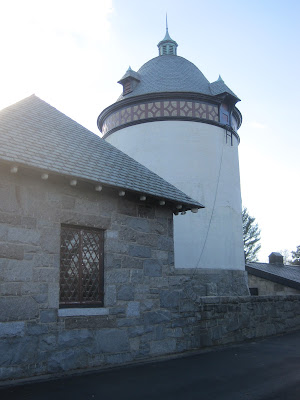







































































.jpeg)







.jpg)





















.JPG)


























































